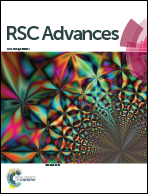Fabrication of La2NiO4 nanoparticles as an efficient bifunctional cathode catalyst for rechargeable lithium–oxygen batteries†
Abstract
Efficient catalysts for oxygen evolution reaction (OER) and oxygen reduction reaction (ORR) are crucial enabling materials for rechargeable Li–O2 batteries. In the present work, La2NiO4 (LNO) synthesized by a hydrothermal process and modified Pechini method were studied as catalysts for rechargeable Li–O2 batteries. The catalyst prepared by the hydrothermal method shows a smaller particle size and a macroporous structure with 10× higher surface area than that synthesized by the Pechini counterpart, leading to a better electrocatalytic activity. The improved OER catalytic activity of the hydrothermal-LNO nanoparticles was confirmed by a 150 mV lower recharge potential than the Pechini-LNO particles and catalyst-free pure Super P (SP) electrode. In addition, the hydrothermal-LNO catalyzed battery cell delivered a first discharge capacity of 14 310.9 mA h g−1 at 0.16 mA cm−2, compared to 8132.4 mA h g−1 of the Pechini-LNO and 7478.8 mA h g−1 of the pure SP electrode, demonstrating higher catalytic ORR activity of the hydrothermal-LNO particles. Overall, the LNO nanoparticles are a promising cathode catalyst for non-aqueous electrolyte based Li–O2 batteries.


 Please wait while we load your content...
Please wait while we load your content...